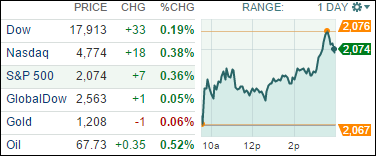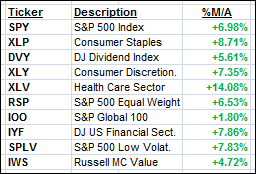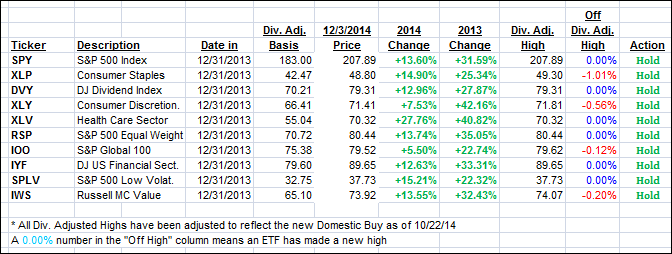1. Moving the Markets
Another day of record highs for the S&P and Dow. Surprised? Not really. Both the S&P 500 and the Nasdaq rose 0.38%, while the Dow gained 0.18%. Again, the continued increase in the S&P 500 bodes the question; will it hit 2,100 by the end of the year?
Energy stocks led gainers again today and shook off recent tumbling commodity prices. Halliburton (HAL), Cinamerx Energy (XEC), British Petroleum (BP) and Schlumberger (SLB) were the leaders. In ETFs, the Energy Select Sector SPDR ETF (XLE) was the big gainer, up 1.2%.
We also received a mixed batch of economic news today. The private sector added 208,000 jobs in November, said payroll processor ADP, which was below the estimated 226,000 figure. However, services firms expanded at a faster pace in November, a signal that overall economic growth should remain robust through the end of year.
Many investors will be focusing on the European Central Bank’s meeting on Thursday, hoping that ECB President Mario Draghi and committee will decide to purchase more government bonds as part of the next round of stimulus measures.
9 of our 10 ETFs in the Spotlight closed on the plus side with 6 of them making new highs. See the YTD table for details.
2. ETFs in the Spotlight
In case you missed the announcement and description of this section, you can read it here again.
It features 10 broadly diversified ETFs from my HighVolume list as posted every Monday. Furthermore, they are screened for the lowest MaxDD% number meaning they have been showing better resistance to temporary sell offs than all others over the past year.
Here are the 10 candidates:
The above table simply demonstrates the magnitude with which some of the ETFs are fluctuating in regards to their positions above or below their respective individual trend lines (%M/A). A break below, represented by a negative number, shows weakness, while a break above, represented by a positive percentage, shows strength.
Year to date, here’s how the above candidates have fared so far:
Again, the first table above shows the position of the various ETFs in relation to their respective long term trend lines (%M/A), while the second one tracks their trailing sell stops in the “Off High” column. The “Action” column will signal a “Sell” once the -7.5% point has been taken out in the “Off High” column.
3. Trend Tracking Indexes (TTIs)
Our Trend Tracking Indexes (TTIs) again inched deeper into bullish territory.
Here’s how we ended up:
Domestic TTI: +3.69% (last close +3.39%)—Buy signal since 10/22/2014
International TTI: +1.48% (last close +1.36%)—New Buy signal effective 11/24/14
Disclosure: I am obliged to inform you that I, as well as advisory clients of mine, own some of these listed ETFs. Furthermore, they do not represent a specific investment recommendation for you, they merely show which ETFs from the universe I track are falling within the guidelines specified.
Contact Ulli



Comments 1
Even as the Obama White House was busy touting its Friday jobs report, CNBC’s Jeff Cox looked deeper inside the government’s data and discovered that the actual increase of working Americans numbers a paltry 4,000.
Worse, reports Cox, “the jobs that were created skewed heavily toward lower quality. Full-time jobs declined by 150,000, while part-time positions increased by 77,000.”
Adding to the disappointing news, says Cox, is the fact that “there were 110,000 fewer married men at work, while married women saw their ranks shrink by 59,000.”
The Republican National Committee wasted no time demystifying the hype surrounding the Obama jobs numbers.
“We’re still faced with Carter-era levels of labor force participation,” said RNC Chairman Reince Priebus in a statement. “Creating 300,000 jobs in one month shouldn’t be a new high; it should be the minimum we expect.”
Even reliably progressive media outlets including Huffington Post were forced to concede that the jobs report was no cause for celebration. Indeed, wages have grown just 2.1%, a figure only slightly above the 2% rate of inflation. And as Market Watch notes, “seasonal (that is, temporary) hiring probably made the November jobs report look a little better than it really was.”
As CNS News points out, the number of working age Americans in the U.S. labor force remains at a 36-year low. In total, 92,447,000 American are no longer in the labor force.
Note:Obama brought control over the Census Bureau under direct White House control back in 2010, and it wasn’t to help count people.